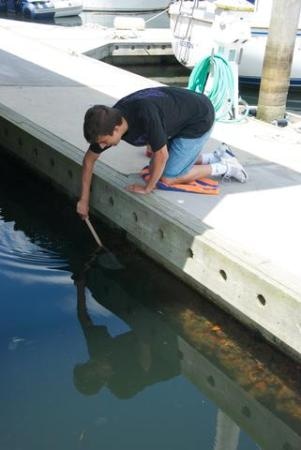May 7 2018
A new composite material that is flexible, non-toxic, sustainable, and UV light-reflective has been developed after a team of researchers from the National Institute of Standards and Technology (NIST) combined derivatives of two leftover materials—wood pulp and dried-up pieces of an invasive exotic pest.
 Tunicates are often found growing in abundance along docks and piers in warm-water locations, far from their native range. (Image credit: Johan Foster)
Tunicates are often found growing in abundance along docks and piers in warm-water locations, far from their native range. (Image credit: Johan Foster)
The material has been described in a new paper published in Advanced Functional Materials. It could soon be used in a wide range of applications, including food packaging, building construction, biomedical devices, and the design of trucks, cars, and boats.
The key to this improbable union of wood and pests is a motif known as the “Bouligand structure,” in which molecules stack up in a twisted shape, similar to minute spiral staircases. Researchers have learned that the Bouligand structure offers a definite kind of resilience to cracking; the force of an impact is guided by those minute, nanosized, staircase-like twists and turns through a sequence of detours. Instead of cracking straight through, the energy of a crash or bump is thus deflected via a kind of tortuous path, leaving the whole material intact and functional.
While wood does not possess a natural Bouligand structure, it has appealed to scientists for years, partly because there is a sufficient supply of material left over after the processing of commercial lumber and paper.
“The idea of making useful products out of wood pulp has long intrigued a lot of people in many different industries,” says Jeff Gilman, who leads the composites project team at NIST.
By washing that pulp with acid to eliminate its amorphous cellulose and lignin, scientists learned many years ago that they could make a milky solution that eventually dried to form a new material with a Bouligand structure. The main component of this solution was minute crystalline rods of cellulose, called nanocellulose or cellulose nanocrystals. However, on their own, the pulp-derived Bouligand films are fragile and will not hold much weight.
The NIST team hypothesized that incorporating the short wood-derived nanocellulose rods with another natural material with longer crystalline rods would result in something new that would be extremely flexible and strong. With suitable additives, this new material could be used to form films that could decelerate the diffusion of water and oxygen.
“The right product, if developed, could be used in everything from aerospace composites to packaging that would keep food fresh,” Gilman said.
One possibility for the new composite material: the carcasses of a dried-up aquatic creature known as a tunicate that is thought of as a pest in a few countries and a delicacy in others.
In several parts of Asia, the brown aquatic creatures (Styela clava) are frequently cooked and served in spicy sauces. But as they do not have any natural predators to eat them in new environments, their populations start to grow into super-abundant numbers that ultimately clog boat engines and fishing gear, reduce healthy plankton populations, outcompete native fish, and foul and destroy productive shellfish beds. Various environmental managers think that discovering a way to remove and use them as a resource could serve an advantageous purpose. Harvesting them is one choice. Like an oyster, the inside of a tunicate is said to be the tasty portion. The outside is typically just discarded, meaning there could be a ready source for this material in areas where they are frequently cooked.
What particularly intrigued the NIST team, however, was the inner structure of the tunicate, which was composed of very long, highly crystalline nanocellulose. These were unlike the shorter crystals observed in wood.
“Tunicates have stuck out as the gold standard for their physical properties,” said Johan Foster from Virginia Tech University, who is in one of the few teams working on tunicate harvest and research worldwide. Foster collected and supplied the tunicates for the NIST project from a dock in Western France, where the animals are thought to be a nuisance species.
A few researchers had assumed that a composite made fully out of long crystalline tunicate nanocellulose would be extremely sturdy and tough. However, by examining dried mixed tunicate/wood composite materials, lead author Bharath Natarajan was able to identify the precise point of maximum toughness.
If you put a little tunicate into the wood pulp composite, it makes it a little stiffer, and it doesn’t break as quickly and becomes more flexible. Put in 10 percent and it’s twice as strong. If your mixture is 30 percent tunicate and 70 percent wood pulp, the resulting composite is 15-20 times tougher. But after that, you really don’t see an improvement in strength, and there is a reduction in toughness.
Bharath Natarajan, Lead Author
Tunicates are abundant, but continue to be uneconomical to process, so knowing precisely how much to incorporate is key to scaling up their use going forward, and for keeping any resultant products reasonably priced.
Integrating the tunicates also resulted in the nanocrystals twisting in a different way and accelerated the structure development in the wood pulp. It also formed a pattern that was denser and tighter, rendering the new composite material UV-reflective.
“Many materials begin to degrade if they are exposed to the sun for a long time,” said Gilman. “This material could potentially be used as a coating on other surfaces in order to reflect light and extend durability.”
In the following years, Natarajan and his team will pursue finding out how their new tunicate-wood pulp mixture could be used to make resilient, flexible, and UV-reflective composites for use in the manufacture of sustainable, lightweight aerospace vehicles and automobiles, among other products.